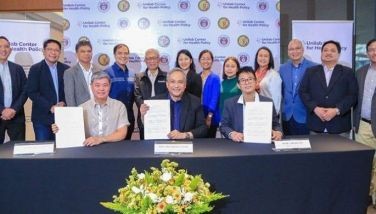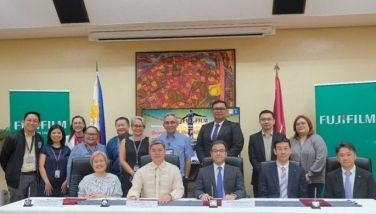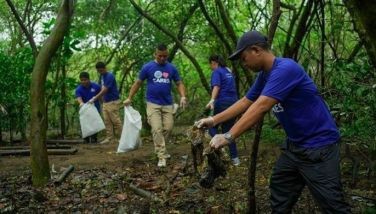The Aginid
CEBU, Philippines - In the course of that mentor-trainee relationship I shared with this paper’s former city editor Marivir Montebon, she passed on to me a book she penned entitled “Retracing our roots – A journey into Cebu’s pre-colonial past” upon knowing how much I hunger for information about Bisdak civilization even before the Spanish conquest.
In there were excerpts of the story of pre-colonial Cebu according to the Aginid, Bayok sa atong Tawarik (Glide on, Odes to Our History) as translated by Jovito Abellana. But the selection did not make much sense until the life, works and writings of Abellana - playwright and novelist par excellence – were featured as one of four exhibits at the Museo Sugbo last month.
The Aginid was in one of those glass cases at the museo’s new galleries. Aginid is a poem that speaks of both fact and fiction I never learned back in grade school. Not even from my most revered La Sallian teachers who were the superlatives when it comes to teaching.
The Aginid is about Sri Lumay of Sumatra who settled in Sugbo with his son, Sri Alho, ruling the south known as Sialo which included Valladolid, Carcar, up to Santander. This should have long been part of our required readings.
“His other son, Sri Ukob, ruled the north known as Nahalin which includes the present towns of Consolacion, Liloan, Compostela, Danao, Carmen, and Bantayan. As a ruler, Sri Lumay was known to be strict, merciless, and brave. He assigned magalamags to teach his people to read and write ancient letterings. He ordered routine patrols by boats from Nahalin to Sialo by his mangubats (warriors).
“Although a strict ruler, Sri Lumay was a loving person that not a single slave ran away from him. During his reign, the Magalos (literally destroyers of peace) who came from Southern Mindanao from time to time invaded the island to loot and hunt for slaves. Sri Lumay commanded to burn the town each time the southerners came to drive them away empty handed. Later, they fought these Magalos (Moro raiders) so that they leave the town for good.
“The town was thus permanently called Kang Sri Lumayng Sugbo, or Sri Lumay’s scorched town. Trading was vibrantly carried on by Sri Lumay’s people with merchants from China, Japan, India, and Burma in Parian, located at the northeastern part of Cebu City.
“The archipelago was strategically positioned in southeast Asia that it naturally became part of the trade route of the ancient world. Agricultural products were bartered for Chinese silk cloths, bells, porcelain wares, iron tools, oil lamps, and medicinal herbs. From Japan, perfume and glass utensils were usually traded with native goods. Ivory products, leather, precious and semi-precious stones and sarkara (sugar) mostly came from the Burmese and Indian traders.
“Sri Lumay was killed in one of the battles against the magalos and was succeeded by his youngest son Sri Bantug who ruled Singhapala (Mabolo district today).
“Bantug carried on his father’s rules throughout his reign. He organized umalahukans (reporters) to urge people in Nahalin and Sialo to obey his orders, especially on agricultural production and defense.
“During Sri Bantug’s time, Sugbo, Nahalin, and Sialo thrived on subsistence, self-sufficient economy. He died in an epidemic which spread in the island and was succeeded by his youngest son Sri Humabon.
“Under Humabon, the sibo or sibu in Parian became more progressive. Here, the “sinibuayng hingpit” (meaning a place for full trade) was carried on. The word Cebu is thus coined from the old word sibo, an old word for barter, trade, or swap.
“At this time, Lapulapu Dimantag arrived from Borneo and asked Humabon for a place to settle. Being an orang laut (man of the sea), Humabon offered the Opong island but Lapulapu was later convinced to settle in Mandawili (now Mandaue) and make the land productive as it was impossible to cultivate food crops in Opong because of its rocky terrain. Under Lapulapu’s leadership, trading in Parian further flourished because of the goods which he brought from the land and sea in northern Cebu. It did not take long though that his relationship with Humabon turned hostile.
“Lapulapu eventually became a mangatang (pirate) who ordered his men to loot ships that pass by Opong island. This had lowered the trading transactions in Parian, thus creating tension between Humabon and Lapulapu. Opong island thus earned the ill-reputed name mangatang which later evolved into the word Mactan.”
Then the Spanish conquistadores arrived on Visayan shore. The Aginid retells the story as to how Lapulapu outplayed, outlasted and outwitted Magellan and how we had come to embrace Christianity and the Sinulog festivity carried on until today.
If it weren’t for last month’s assignment at the Museo Sugbo, I wouldn’t have been able to substantiate how Marivir’s gift of “retracing” introduced me to the Aginid. Watching the brittle parchment now, I did feel shame and guilt that I had first studied the western world, and read and known less of my own “sibo tawarik.”
- Latest
- Trending



















